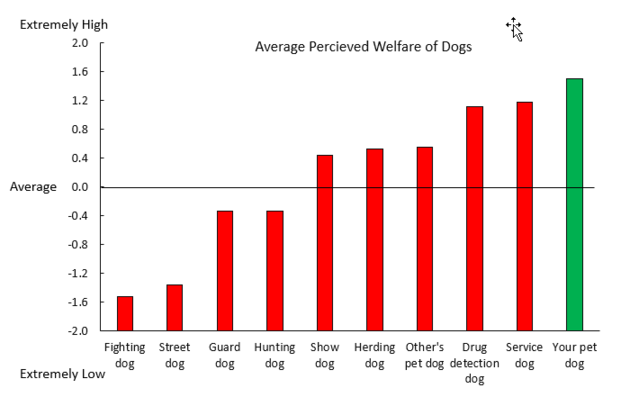Animal Behavior
Does Your Dog Really Have a Better Life Than Other Dogs?
Of the billion dogs on earth, which fare the best?
Posted November 4, 2022 Reviewed by Tyler Woods
Key points
- The various dogs on earth live vastly different lives.
- In a recent study, subjects rated the welfare of dogs, ranging from street dogs and fighting dogs to show dogs and personal pets.
- Nearly everyone thought their dog had a better life than other types of dogs—including other peoples' pets.
- This finding could be due to a cognitive bias called "the Lake Wobegon Effect"—the tendency for people think they are above average.

There are a billion or so dogs on our planet, and they live in a wide array of settings—some great, some terrible. A recent study compared perceptions of the welfare of dogs in these different settings. Some of the results were surprising—particularly how people rated the well-being of their dog compared to other pet dogs.
Most dogs on earth are not treated like the typical American pet dog—a doted-on furry family member. Between 60 and 85 percent of dogs worldwide are free-ranging street/village dogs who live around humans but are not owned. While they need to scrounge around for food and rarely receive veterinary care, unlike our pampered pets, they get to call their own shots.
Then there are the dogs bred and kept for their ability to fight, hunt, or guard, and the dogs who have jobs like detecting drugs, locating human remains, visiting nursing homes, and guiding the blind. The list goes on.
The study on our perceptions of comparative canine welfare was conducted by a team of Australian anthrozoologists led by Mia Cobb, a research fellow at the University of Melbourne. Their results were published in the journal Animal Welfare. In an email, Mia told me, “The study was initially designed because I was interested in whether other people were as concerned about working dog welfare as I was. But the findings really opened my eyes and raised a whole new bundle of questions about how people think about dogs and what we believe we know.”
For Better or For Worse? Comparative Canine Welfare
The study was simple. Using social media platforms and web forums, the researchers recruited 2,147 subjects who completed a brief online survey related to canine welfare. About half of the participants were from Australia and another 25 percent were from the U.K. and the U.S. As is often the case in human-animal interaction studies, most of the subjects (81 percent) were women. (See Women Dominate Research on the Human-Animal Bond.)
In the first part of the questionnaire, the participants rated the “quality of life” of their dog on a five-point scale from “extremely low” to “extremely high.” In the second section, they rated their perceptions of 17 other types of dogs, including guard dogs, herding dogs, explosive and drug detection dogs, search and rescue dogs, service dogs, and guide dogs for the blind. The subjects also rated the welfare of street dogs, feral dogs, fighting dogs, sled-racing dogs, pedigree show dogs, and other people’s pet dogs. The subjects were also asked about the extent they agreed or disagreed with the statement, “The welfare of dogs is very important to me.”
When It Comes to Quality of Life, All Dogs Are Not Equal
The authors found vast differences in how the subjects rated the welfare of different types of dogs. This graph shows the average perceived welfare of eight of the categories of dogs in the study.

- Fighting dogs and street dogs were thought to have the worst welfare. (But as Psychology Today blogger Marc Bekoff has pointed out, street dogs can have better lives than many pet dogs. See Are Pet Dogs Really Better Off than Free-Ranging Canines?)
- Surprisingly, the welfare of pampered, purebred show dogs was perceived to be lower than the welfare of pet dogs and working dogs. The researchers thought this could be due to the genetic disorders that affect many types of purebred dogs.
- Farm livestock dogs and sled-racing dogs were thought to have a lower quality of life than other types of working dogs. The researchers speculated that this is because they spend more time exposed to the outdoors and are engaged in riskier activities.
- Dogs who worked closely with humans in professional contexts, such as guide dogs, police dogs, and search and rescue dogs, were rated as having high to very high welfare.
Is My Dog Better Off than Your Dog? Canine Welfare and the “Lake Wobegon Effect”
One of the most interesting findings was related to how owners perceived the well-being of their personal pets when compared to the welfare of other dogs. Dogs living in human homes certainly have it better than dogs used for fighting or greyhound racing. But the researchers found that their participants also thought that their dogs had better lives than other people’s pets. The subjects rated “other people’s pets” as having “average welfare”—about the same as herding dogs. Yet 95 percent of the subjects rated their dogs as having extremely high welfare or high welfare. Indeed, according to Cobb, everyone in the study thought their pet had better welfare than dogs in all of the other categories, including the “other people’s pet dog” category.
"This was quite an unexpected finding," she wrote. "In hindsight, we probably should have expected it; people give themselves better-than-average self-rating in other areas, like driving and parenting.”
Mia is right. It is possible that the subjects in the study were indeed better-than-average pet owners. But the tendency to think your dog has a better life than other dogs also reflects “The Lake Wobegon Effect.” This is the natural human tendency for people to think they are above average in many domains. It is named after Garrison Keiller’s fictional town where “all the women are strong, all the men are good-looking, and all the children are above average. As Psychology Today blogger Lawrence White wrote, “Most of us think we’re funnier, smarter, warmer, more honest, or more conscientious than we really are.”
And it seems that most of us like to think we rank near the top when it comes to being great dog owners.
References
Cobb, M. L., Lill, A., & Bennett, P. C. (2020). Not all dogs are equal: Perception of canine welfare varies with context. Animal Welfare, 29(1), 27-35.


